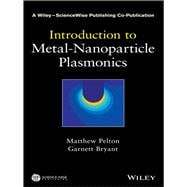
What is included with this book?
MATTHEW PELTON, PhD, is a Physicist at the Center for Nanoscale Materials, Argonne National Laboratory, researching the new physical phenomena that arise when light interacts with nanomaterials.
GARNETT BRYANT, PhD, is a Supervisory Physicist at the National Institute of Standards and Technology (NIST) where he is the Group Leader of the Quantum Processes and Metrology Group conducting research on nanosystems and nanophotonics.
Introduction xi
I.1 Why All the Excitement? xi
I.2 Historical Perspective xiv
I.3 Book Outline xvii
1 Modeling: Understanding Metal-Nanoparticle Plasmons 1
1.1 Classical Picture: Solutions of Maxwell’s Equations 2
1.2 Discrete Plasmon Resonances in Particles 13
1.3 Overview of Numerical Methods 25
1.4 A Model System: Gold Nanorods 31
1.5 Size-Dependent Effects in Small Particles 39
References 46
2 Making: Synthesis and Fabrication of Metal Nanoparticles 51
2.1 Top-Down: Lithography 52
2.2 Bottom-Up: Colloidal Synthesis 67
2.3 Self-Assembly and Hybrid Methods 76
2.4 Chemical Assembly 86
References 92
3 Measuring: Characterization of Plasmons in Metal Nanoparticles 97
3.1 Ensemble Optical Measurements 97
3.2 Single-Particle Optical Measurements 102
3.3 Electron Microscopy 125
References 132
4 Coupled Plasmons in Metal Nanoparticles 135
4.1 Pairs of Metal Nanoparticles 136
4.2 Understanding Complex Nanostructures Using Coupled Plasmons 149
References 161
5 Nonlinear Optical Response of Metal Nanoparticles 165
5.1 Review of Optical Nonlinearities 166
5.2 Time-Resolved Spectroscopy 170
5.3 Harmonic Generation 187
References 191
6 Coupling Plasmons in Metal Nanoparticles to Emitters 193
6.1 Plasmon-Modified Emission 193
6.2 Plasmon–Emitter Interactions Beyond Emission Enhancement 210
References 225
7 Some Potential Applications of Plasmonic Metal Nanoparticles 229
7.1 Refractive-Index Sensing and Molecular Detection 229
7.2 Surface-Enhanced Raman Scattering 233
7.3 Near-Field Microscopy, Photolithography, and Data Storage 239
7.4 Photodetectors and Solar Cells 242
7.5 Optical Tweezers 249
7.6 Optical Metamaterials 254
References 266
Index 271
The New copy of this book will include any supplemental materials advertised. Please check the title of the book to determine if it should include any access cards, study guides, lab manuals, CDs, etc.
The Used, Rental and eBook copies of this book are not guaranteed to include any supplemental materials. Typically, only the book itself is included. This is true even if the title states it includes any access cards, study guides, lab manuals, CDs, etc.